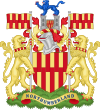Northumberland
| Hrabstwo ceremonialne i unitary authority | |||||
 Wał Hadriana przebiegający przez hrabstwo | |||||
| |||||
| Państwo | |||||
|---|---|---|---|---|---|
| Kraj | |||||
| Region | |||||
| Siedziba | |||||
| Powierzchnia | 5014 km²[1] | ||||
| Populacja (2016) • liczba ludności |
| ||||
| • gęstość | 63 os./km² | ||||
| Szczegółowy podział administracyjny | |||||
| Liczba unitary authorities | 1 | ||||
Położenie na mapie | |||||
| Strona internetowa | |||||
| Portal | |||||
Northumberland (wym. [nɔrˈθʌmbərlənd]) – hrabstwo ceremonialne i historyczne oraz jednostka administracyjna typu unitary authority w północno-wschodniej Anglii, w regionie North East England, położone przy granicy ze Szkocją, nad Morzem Północnym.
Powierzchnia hrabstwa wynosi 5014 km², a liczba ludności – 316 002 (2016)[1]. Z gęstością zaludnienia wynoszącą 63,0 os./km² jest to najrzadziej zaludnione hrabstwo Anglii. Ośrodkiem administracyjnym hrabstwa jest Morpeth a największym miastem – Blyth. Innymi większymi miastami na terenie hrabstwa są Cramlington, Ashington, Bedlington oraz Berwick-upon-Tweed[2].
W północno-wschodniej części hrabstwa znajdują się niskie góry Cheviot Hills a na zachodzie i południowym zachodzie Góry Pennińskie. Wschodnią, nadmorską część zajmuje nizina. Na terenie hrabstwa znajduje się Park Narodowy Northumberland.
Na północy Northumberland graniczy ze Szkocją, na zachodzie z Kumbrią, na południowym zachodzie z hrabstwem Durham a na południowym wschodzie z Tyne and Wear.
Podział administracyjny
Obecny
Obszar hrabstwa ceremonialnego jest tożsamy z obszarem zajmowanym przez jednostkę administracyjną unitary authority Northumberland.
Do 2009
Przed reformą administracyjną przeprowadzoną w 2009 roku Northumberland było hrabstwem niemetropolitalnym, w którego skład wchodziło sześć dystryktów. Granice hrabstwa ceremonialnego były, tak jak i obecnie, identyczne z granicami jednostki administracyjnej.
Mapa
Zobacz też
Przypisy
- ↑ a b c MYE5: Population estimates: Population density for the local authorities in the UK, mid-2001 to mid-2016, [w:] Population Estimates for UK, England and Wales, Scotland and Northern Ireland – Mid-2016 [online], Office for National Statistics [dostęp 2017-10-21] (ang.).
- ↑ a b Office for National Statistics: KS101EW - Usual resident population. [w:] 2011 Census [on-line]. Nomis – Official labour market statistics, 2013-02-12. [dostęp 2022-06-05]. (ang.).
- ↑ Office for National Statistics: Built-up Area to Local Authority District (December 2011) Lookup in England and Wales. [w:] Open Geography Portal [on-line]. [dostęp 2022-06-05]. (ang.).
- ↑ Office for National Statistics: Built-up Area Sub Divisions (December 2011) Boundaries. [w:] Open Geography Potal [on-line]. [dostęp 2022-06-05]. (ang.).
Bibliografia
- Northumberland, [w:] Encyclopædia Britannica [online] [dostęp 2012-07-28] (ang.).
Media użyte na tej stronie
Flag of England. Saint George's cross (a red cross on a white background), used as the Flag of England, the Italian city of Genoa and various other places.
Flag of Northumberland
Contains Ordnance Survey data © Crown copyright and database right, CC BY-SA 3.0
Map of Northumberland, UK with the following information shown:
- Administrative borders
- Coastline, lakes and rivers
- Roads and railways
- Urban areas
Equirectangular map projection on WGS 84 datum, with N/S stretched 170%
Geographic limits:
- West: 2.85W
- East: 1.35W
- North: 55.83N
- South: 54.77N
Autor: Michael Hanselmann, Licencja: CC BY-SA 3.0
Hadrian's wall between Housesteads and Once Brewed.
Autor: Nilfanion, Licencja: CC BY-SA 3.0
Location of the ceremonial county of Northumberland within England.











